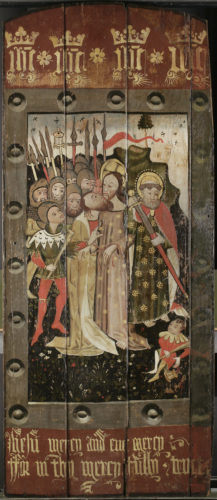Knowledge of the divine had long been thought to be ‘built into’ Church architecture. The biblical stories illustrated in stained glass windows, wall paintings, and statues were described by Pope Gregory as books for the illiterate, containing the knowledge needed for salvation. After the Reformation, much of this changed; statues were defaced or torn down, and wall paintings were whitewashed. Instead of relying on external images, individuals were supposed to search for evidence of faith and grace in the metaphorical ‘temple’ of the human heart.
These beautiful images – an English wall-painting from the mid-fifteenth century and a French stained-glass panel from around eighty years later – illustrate key moments in the story of the Crucifixion. The former is a rare survival from the late medieval period; many similar paintings were destroyed by Reformers, who saw such images as idols that transgressed the second commandment’s injunction against ‘graven images’, and which distracted the worshiper from a properly spiritual contemplation of God. This particular example seems to have endured partly because it was re-purposed: the back of the panel has been inscribed with the Ten Commandments.
In Catholic France, the risk of iconoclasm was less extreme. It is, though, worth noting that even in England and other Protestant countries, stained glass was more likely to survive Reformist iconoclasm than other kinds of religious art. This is because it would have been expensive to replace the damaged windows – a reminder of how religious considerations have always interacted with more worldly concerns!
Anon., The Last Supper. Rouen, 1542. Royal Collection Trust / © Her Majesty Queen Elizabeth II 2019.
www.rct.uk/collection/74427












